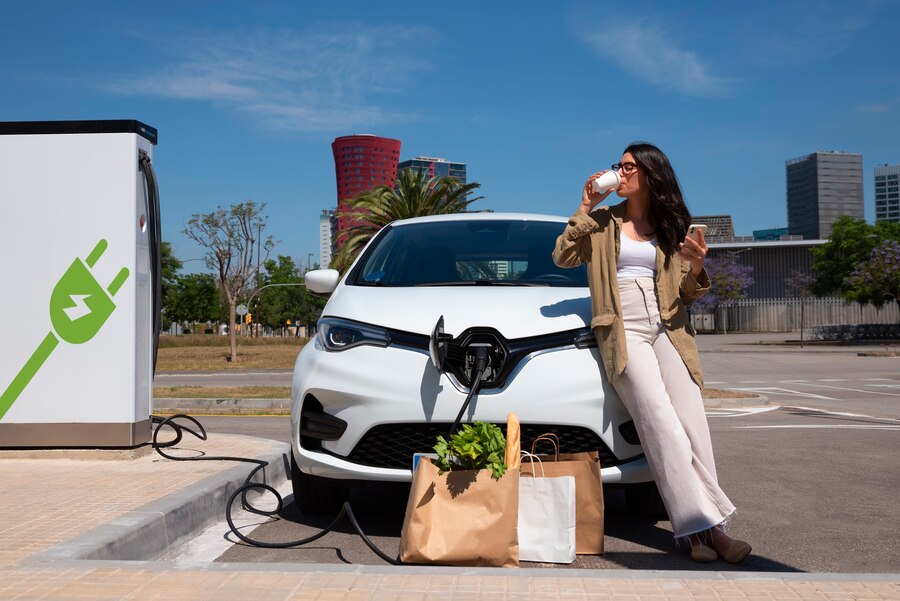Introduction
The global shift toward environmentally friendly transportation has gained significant momentum over the past ten years. The rise of electric vehicles (EVs), which promise to reduce the world’s reliance on fossil fuels and revolutionize the automotive industry, lies at the heart of this transition. Governments, automakers, and consumers are increasingly embracing electric vehicles due to their environmental benefits, technological advancements, and economic potential. Electric vehicles have emerged as a cleaner and more efficient alternative to traditional internal combustion engine (ICE) cars in response to growing concerns about climate change, air pollution, and the volatility of oil prices. The development of electric vehicles, their technology, their advantages and disadvantages, and the prospects for environmentally friendly transportation are the subjects of this article.

History and Evolution of Electric Vehicles
Electric cars have been around for a long time. The concept of electric-powered transportation dates back to the early 19th century:In 1828, Hungarian inventor Ányos Jedlik created a small-scale electric motor and fitted it into a vehicle.In 1832, Scottish inventor Robert Anderson built the first crude electric carriage powered by non-rechargeable batteries.By the late 19th century, electric cars gained popularity due to their ease of use and quiet operation compared to noisy, smoke-producing gasoline-powered cars.In the early 1900s, electric cars were widely used in cities because they were easier to operate than gasoline cars, which required manual cranking. In fact, in 1900, electric vehicles accounted for about 33% of all cars on the road in the United States. However, Charles Kettering’s 1912 invention of the electric starter made gasoline cars easier to operate, resulting in the demise of electric vehicles.
Decline and Dormancy (1920s – 1970s)
The mass production of gasoline-powered cars, spearheaded by Henry Ford’s Model T, made gas-powered cars more affordable and accessible to the average consumer.Improved road networks and the discovery of large oil reserves further boosted the dominance of gasoline cars.Electric cars became rare due to limited battery technology and shorter driving ranges.
Revival and Early Adoption (1970s – 1990s)
In the 1990s, stricter environmental regulations and advancements in battery technology led to the introduction of electric cars like the GM EV1, but production was limited due to high costs and infrastructure limitations. The oil crisis of the 1970s rekindled interest in electric cars as governments and automakers sought to reduce their reliance on imported oil. Companies like General Motors experimented with prototypes of electric vehicles.
Modern Era and Rapid Growth (2000s – Present)
The 21st century marked the true rise of electric vehicles:In 2008, Tesla introduced the Tesla Roadster, the first production electric car with a lithium-ion battery capable of driving over 200 miles on a single charge.The release of the Nissan Leaf in 2010 made electric vehicles more accessible to the mass market.Major automakers like BMW, Volkswagen, and Ford began investing heavily in electric car technology.Today, electric vehicles have become mainstream, with global sales increasing each year. Globally, ambitious goals have been set by governments to phase out gasoline and diesel vehicles in favor of electric ones.
How Electric Vehicles Work
Instead of gasoline or diesel, electric vehicles are powered by electricity stored in batteries. An electric vehicle’s essential components include: Battery PackMost electric vehicles use lithium-ion batteries due to their high energy density, lightweight design, and long lifespan.Battery capacity is measured in kilowatt-hours (kWh) — the higher the kWh, the longer the driving range.
Electric Motor
The electric motor converts electrical energy from the battery into mechanical energy to drive the wheels.Electric motors provide instant torque, resulting in quick acceleration and smooth handling.
Inverter
The inverter transforms the battery’s direct current (DC) into the motor’s alternating current (AC). Some electric vehicles employ AC motors, while others employ DC motors.
Charging System
Electric cars can be charged using:Home chargers both Level 1 and 2Public charging stations Level 3 or DC fast chargingWireless charging being developedThe size of the battery and the kind of charging station used affect how long it takes to charge. Regenerative BrakingRegenerative braking captures energy from braking and feeds it back into the battery, improving energy efficiency and extending driving range.
Benefits of Electric Vehicles
Environmental Benefits
Zero Emissions: Electric vehicles produce no tailpipe emissions, reducing air pollution and improving air quality.Lower Carbon Footprint: When charged using renewable energy solar, wind, hydro EVs have near-zero emissions.Noise Reduction: Electric motors are quiet, contributing to less noise pollution in cities.
Economic Benefits
Lower Operating Costs: Electricity is cheaper than gasoline, and electric vehicles require less maintenance due to fewer moving parts.Government Incentives: Many governments offer tax credits, rebates, and purchase incentives for electric vehicle buyers.Job Creation: The electric vehicle industry is driving job creation in battery manufacturing, charging infrastructure, and vehicle production.
Performance and Driving Experience
The absence of an internal combustion engine results in a quieter and smoother driving experience. All-Wheel Drive (AWD) Capability: Many electric cars feature dual or multiple motors for improved traction and stability. Instant Torque: Electric cars deliver quick acceleration and responsive handling. Smooth Ride:
Challenges Facing Electric Vehicles
High Initial Costs
Due to the cost of producing batteries, electric vehicles continue to be more expensive than gasoline-powered vehicles. Limited Charging Infrastructure The number of charging stations that are available is getting better, but they are still few and far between in rural and underdeveloped areas. Fast charging networks are growing, but they are still not as common as gas stations.
Battery Performance and LifespanDriving range is reduced over time by battery degradation, and extreme temperatures can affect battery performance. The mining of nickel, cobalt, and lithium raises ethical and environmental concerns, and battery recycling and disposal remain problematic.
Automaker Investment
Increasing investments are being made in solid-state battery technology and autonomous electric vehicles. Tesla, Volkswagen, BMW, and Ford have all made commitments to switching to entirely electric product lines.
Renewable Energy Integration
Governments are investing in renewable energy infrastructure to power electric cars using solar, wind, and hydro energy.Vehicle-to-grid V2G technology allows electric cars to store and return power to the grid.
Future of Electric Vehicles
Autonomous Electric Vehicles
Self-driving electric cars ill improve road safety and reduce traffic congestion.Companies likwe Tesla and Waymo are leading the development of autonomous EVs.
Solid-State Batteries
Compared to lithium-ion batteries, solid-state batteries promise faster charging times, a longer lifespan, and greater safety. Automakers want to use solid-state battery technology by 2030.
Expansion of Charging Infrastructure
To alleviate range anxiety, governments and private businesses are developing fast-charging networks, as well as wireless charging and battery-swapping technology.

Conclusion
A significant shift toward environmentally friendly and sustainable modes of transportation can be seen in the rise of electric vehicles. The widespread use of electric vehicles is being fueled by consumer demand, government support, and technological advancements. While challenges such as high costs and charging infrastructure remain, ongoing innovation and investment are overcoming these barriers.Electric vehicles represent more than just a change in automotive technology they symbolize a cleaner, more efficient, and more sustainable future for global transportation.

